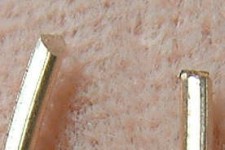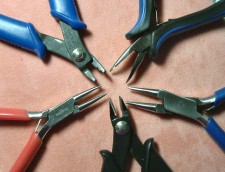Now that we’ve covered what is wire work and wire types, let’s talk a little about the tools for making wire jewelry.
Wire Cutters

One tool that you will definitely need is a good wire cutter; more specifically, a flush cutting wire cutter. Why flush cut? And for that matter, what is flush cut?
When making wire jewelry, one thing you don’t want is to have sharp pieces or wire that could poke the wearer or snag on clothing. A side-cutter will generally cut and leave a sharp point on the wire that you’ll have to file down.
A flush cutter will leave a flat end on the wire that needs little to no filing.
The photo shows an extreme close-up of an angled side cut versus the flat flush cut.
Pliers

If you’ve spent any time reading about making wire jewelry, you know that there are a zillion types of pliers. OK, maybe not that many, but what are staples of the toolbox, and what are nice extras to have?
Personally, I have two kinds of pliers that I use: a round-nose and a chain-nose. However, I have a few different kinds of each.
Round nose pliers are exactly what they sound like: pliers that have round jaws instead of flat ones. I have some that have a very fine tip, for working with smaller gauges of wire. I also have a set with a larger diameter, for heavier wires.
Chain nose pliers have a flat surface for the jaws. And there are two kinds of “flat surface”. One is what it sounds like — smooth. The other has some texture to it. For wire jewelry, you want a smooth surface that won’t mar the wire.
Chain nose pliers can have wide jaws or jaws with a fine tip. They can be straight or have a bent nose.  I have both straight tip and bent nose, in several sizes for different gauges of wire.
Nice to Have Tools
Some tools that are nice to have but aren’t totally necessary include (but aren’t limited to) the following:
- Nylon jaw pliers, to straighten wire and help prevent marring the wire.
- Wire-wrapping pliers have several “steps” to help make even loops of a specific size.
- Crimping pliers; not usually thought of as being used with wire jewelry, but useful for tucking in wire ends.
How Much Should You Pay for Tools?
Ah, the question of how much to pay for your tools for making wire jewelry depends on your skill level and if you’d like to try making wire jewelry, but aren’t sure you’ll like it.
If you are just starting out with wire jewelry and aren’t sure if you will like it, I’d suggest an “economy” set of tools. They aren’t the best quality, but will get the job done.
Once you’ve decided you like wire work, you may want to move up to tools in a mid-range price. While not top-of-the-line, they are better made than the economy tools (which may break on you after being used awhile). These are great for most people who work with wire. OHM is a good example of this kind of quality.
If you make make and sell wire jewelry either part-time or full-time, you’ll want some great tools that will probably last a lifetime. Lindstrom happens to be my favorite manufacturer, but there are others around as well. Expect to pay $50 and up for a pair of pliers, but they are definitely worth it if you work a lot with wire.
I have tools in each category. but for my chain nose pliers, hands down it’s the higher end tools.
Naturally, your own budget will figure into this. But in general I say buy the best tools you can afford.
Meanwhile, I’ll leave you with some flush cut pliers, the most necessary item in your tool box.